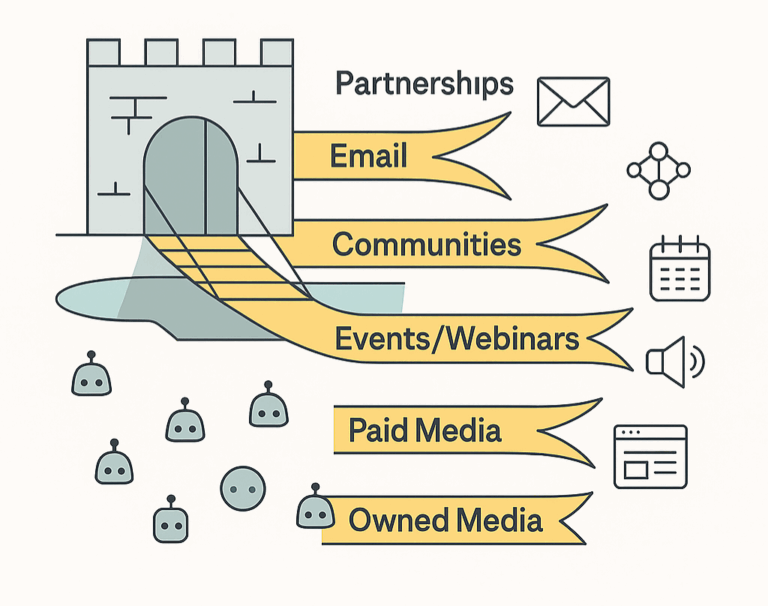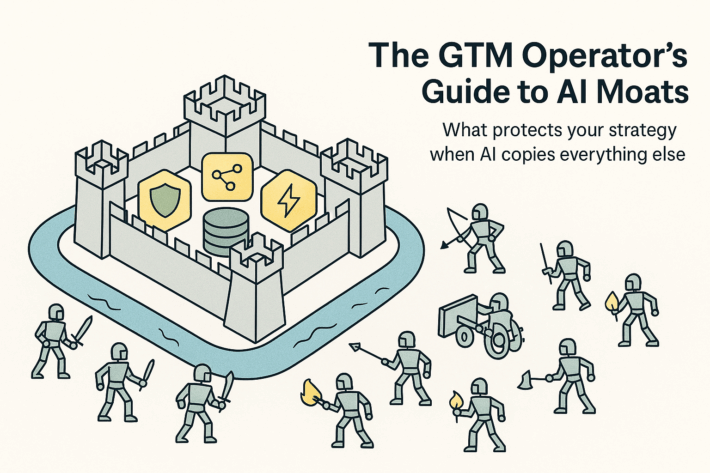How Credibility Becomes Your Strongest GTM Defense

Trust turns hesitation into faster decisions
Trust closes deals faster than features. Learn how B2B SaaS leaders turn transparency, proof, and credibility into a moat in the age of AI.
Missed the start of this series?
Go back to Moat 1: Data — Why Signals Decide Who Wins.
AI makes it easy for anyone to look credible on the surface.
A startup can polish a website in a day, generate testimonials that sound real, throw borrowed logos on a deck, and create the illusion of stability. On the surface everything looks enterprise-ready. The real test comes later — deals in late stage, legal scrutiny, procurement dragging their feet, renewals under pressure from cheaper competitors. That’s when a moat built on credibility starts to matter.
A trust moat takes time to form. It grows from how consistently you show up, how you prove what you claim, how you stay transparent even when it costs you in the short term. It’s what makes a CFO comfortable signing without dragging out the process for another three months. It’s what makes a CISO lean forward because they see evidence instead of promises. It’s what makes users renew because the product held up and the support team stood behind it. Without that foundation, even the strongest data or distribution play can collapse when a deal reaches the point of decision.
Cloudflare made this visible by investing heavily in detailed case studies. Their customer stories are technical, specific, and backed by real companies. Competitors can copy language from their homepage. They cannot fake hundreds of signed accounts with measurable results.
Okta created a live trust signal with their status and trust portal. Buyers don’t need to take anyone’s word for reliability. They see uptime, incidents, and fixes in real time. Most vendors hide outages and publish quarterly uptime summaries. Okta shows the full picture every day, which becomes part of the reason buyers pick them.
Plaid leaned into financial safety. Moving money and handling sensitive data requires more than compliance checkboxes. Their safety page spells out how data flows, how it’s protected, and which banks certify the integrations. Buyers looking at Plaid don’t just hear the word security, they see the mechanics behind it. That clarity makes procurement easier and renewals smoother.
HashiCorp grew trust before the enterprise sale ever started. Open source tools like Terraform built credibility inside engineering teams long before procurement showed up. Developers had already validated the software in their environments. By the time procurement got involved, trust had been earned in practice long before the marketing team entered the picture. HashiCorp resources
Zoom had to recover from early security failures. Instead of hiding, they launched a dedicated trust center and published progress openly. Customers saw the company face problems head-on, which over time turned a weakness into a form of strength. Buyers stayed because they could see change happening in public.
How buyers actually read trust
CFOs read trust through stability and risk signals. They want proof that you’ll still be in business when a three-year contract comes up for renewal. They care about clean audits, financial transparency, insurance coverage, and whether your customer roster includes logos they already trust. Their calculation is simple — if you look shaky, they slow everything down.
CISOs look at trust through the lens of technical evidence. They need to see penetration test results, vulnerability reports, encryption practices, compliance certifications, and even red-team simulations. They look for proof that you’re serious about protecting their brand as well as your own. Without that kind of evidence, they hold up the deal because their own credibility is on the line.
Frontline users feel trust in the day-to-day. They pay attention to whether onboarding works the way it was promised, whether updates improve their experience instead of breaking it, and whether support responds quickly when they hit a wall. They don’t care about audits or certifications, but their confidence determines adoption. If they stop believing, usage slows and renewals get harder.
When one of these groups loses confidence, the entire account wobbles. A real moat covers all three perspectives so the deal can hold under pressure.
How GTM teams create trust day to day
Sales proves credibility by answering questions honestly instead of stretching the truth to win faster. Onboarding proves credibility by showing features that work as described without shortcuts. Customer success proves credibility when they respond quickly, not defensively, and when they come back with solutions instead of explanations. Even marketing plays a role by avoiding exaggerated claims that set the rest of the team up for failure. Trust is built from dozens of small moments that stack into a pattern customers start to believe.
Where companies lose it
They overpromise features and underdeliver, which creates churn and reference risk. They hide outages until social media forces disclosure, which creates the perception of dishonesty. They push out case studies so vague they blur into every other vendor, and buyers stop taking them seriously. They let AI tools generate fake quotes or airbrushed metrics, which may fool a casual reader but gets caught quickly in enterprise cycles. When credibility breaks, the recovery drags on for years and burns resources that could have been spent growing.
Questions to check your own setup
- Would your largest customers agree to a public case study with their logo, their outcomes, and their name attached, or do you still rely on anonymous quotes that buyers know could be fictional?
- Can a prospect land on your site and verify uptime, security posture, or compliance records without contacting support, or do they need to email someone to chase it down?
- Do you hold certifications, independent audits, or proprietary benchmarks that a competitor would struggle to reproduce quickly, or could they catch up in a few months with budget and effort?
- If a regulator or auditor walked in tomorrow, would your team hand over reports calmly and pass, or would you scramble through folders and Slack threads to patch together compliance in a panic?
What it feels like when a trust moat holds
Prospects walk into sales calls already believing because they’ve seen proof in case studies, certifications, or uptime records. Sales cycles move faster because credibility doesn’t need to be built from scratch in every interaction. Renewals move smoother because the product, the support, and the communication all lined up with what was promised. Teams spend less time defending contracts and more time expanding accounts.
Moves that help the moat grow stronger
- Build a trust hub on your site that shows uptime, compliance records, certifications, and incident history in real time. A page that updates automatically becomes a selling tool because it starts the trust conversation before sales ever calls.
- Publish customer stories that show names, before-and-after metrics, and measurable outcomes. Buyers know the difference between fluff quotes and evidence, and they reward the companies that show evidence.
- Create customer councils or advisory boards where respected logos share feedback and show support publicly. Seeing a peer company put their name on the line creates weight that no ad campaign can match.
- Use your dataset to publish anonymized benchmarks that let companies see where they stand in their industry. Those reports become reference points that competitors cannot duplicate without the same data footprint.
- When mistakes happen, document what failed, show how you fixed it, and keep the record public. Buyers remember the vendors who admit errors and show their work, because it signals they can trust you in the long run.
Every moat leans on this one. Data gets questioned when credibility is thin. Distribution burns through budget when buyers hesitate to believe. Systems spin in circles when promises don’t hold up. Communities shrink when confidence slips. Employees disengage when leadership treats truth as optional.
CONTINUE THE SERIES
Moat 3: Distribution
Reach doesn’t protect itself anymore. AI lowered the cost of content and outreach, which means inboxes and feeds are already flooded. A real moat in distribution comes from owning unique channels, relationships, and ecosystems that you can own in the long run.


Jahnavi Ray is a data obsessed marketing leader with 17+ years of experience driving demand, building GTM engines, and mentoring growth-stage B2B teams. She’s led marketing inside startups, scaled systems at global SaaS companies, and now shares her playbooks to help founders and marketers turn chaos into clarity, and pipeline into predictable revenue. When she’s not mapping growth ecosystems or coaching on GrowthMentor, you’ll find her practicing yoga, chasing her two gremlins, or building something meaningful in Toronto.
